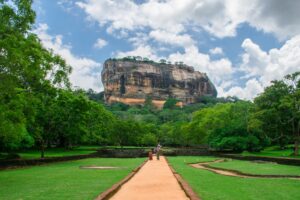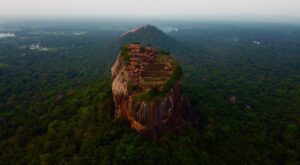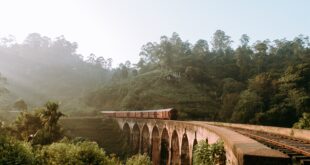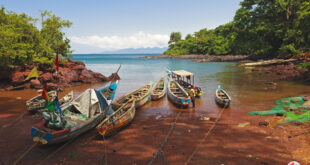
Located within Sri Lanka’s cultural triangle, Sigiriya serves as evidence of the country’s opulent past and skillful architecture. Given its standing as an “Eighth Wonder of the World,” this rock fortress from antiquity stands not just for impressive feats of engineering but also represents a time period marked by grandeur and aspiration that now belongs to history.
The Sigiriya Rock Fortress holds great historical significance. It was built in the 5th century by King Kassapa I and served as his royal palace for several years before being turned into a Buddhist monastery after his death. Its complex architecture, including its iconic Lion Gate, is an important example of ancient Sri Lankan engineering.
Additionally, the frescoes found on some sections of Sigiriya‘s rock face are considered masterpieces of ancient artistry and provide valuable insights into the lifestyle and culture of people from that time period. The site has been recognized UNESCO World Heritage Site due to its importance not only in terms of history but also cultural landscapes it preserves: gardens with water pavilions trees which have grown over centuries can be seen throughout this area giving us insight about how humans interacted their environment so long ago!
The famous “Lion’s Rock” known as Sigiriya stands out as an impressive example of the architectural and cultural accomplishments from ancient Sri Lanka. This fortress, located at the center of the country’s cultural triangle, carries great significance regarding its historical background that entails stories of supremacy, aspirations and exceptional artistic ability. Let us delve into further details about this remarkable site’s importance in history:

During the 5th century AD, Sigiriya became King Kashyapa’s chosen location for his new capital. The monarch – reigning from 477 to 495 AD – crafted an incredible palace atop the rock formation that displayed both his immense wealth and powerful authority. Not only a residential structure but also a symbol of domination over the kingdom itself, this fortress was truly magnificent in every sense of the word.
The Lion’s Paw Entrance of Sigiriya is a remarkable sight, renowned for its grandeur and symbolic significance. Crafted in the shape of an enormous lion, it served as the main entrance to ascend the rock formation. Traversing between its fearsome paws represented reverence towards royalty and power they possess.
While time may have taken its toll on some parts like eroding away part ofthe face; nevertheless, colossal remains still serve as proof that ancient architects had skillful hands capableof bringing such artistic wonders into reality.
The wall leading up to the palace complex is embellished with a lengthy 140-meter Mirror Wall, which was once so exquisitely polished that it reflected like a mirror – hence its nomenclature. Alongside this grandeur lies the Sigiriya frescoes portraying divine nymphs famously known as “Apsaras.” These artworks are celebrated for their intricate details and artistic splendor allowing us glimpses into the aesthetics of that era.
The complex hydraulic mechanisms within the fortress comprised of elaborate water features such as gardens, fountains and storage systems. These cutting-edge designs not only highlighted Sri Lanka’s technological progress but also underscored the imperative role of effective management in ensuring a thriving kingdom through water conservation.
Upon King Kashyapa’s defeat in battle against his half-brother Moggallana, Sigiriya was deserted. It served as a Buddhist monastery until the 14th century before it became engulfed by natural elements and lost to history—until its resurfacing during the 19th-century digs of British archaeologists, who uncovered its impressive ancient fortress design.
The wonders of Sigiriya’s architecture
Sigiriya is a testament to the superb craftsmanship and design of ancient Sri Lanka, featuring an imposing rock fortress with intricate architectural features. It has gained worldwide recognition as a remarkable example of urban planning from early times by blending aesthetic beauty effortlessly with functionality. Let’s explore some exceptional feats of architecture that make Sigiriya truly outstanding!
The Rock and Its Defenses:
Sigiriya’s ingenious architecture is anchored on its natural environment with the rock column standing tall at a height of 200 meters above the flat lands. The colossal formation, acting as a bastion in itself, inspired an array of defensive structures constructed by ancient craftsmen to make it virtually impenetrable from any enemy attack. These included fortifications such as ramparts and moats that further bolstered Sigiriya’s defenses.
Water Gardens:
The rock is encompassed by water gardens that were thoughtfully crafted with a series of pools, channels, and fountains. These gardens served both practical and aesthetic purposes in ancient times. The symmetrical arrangement coupled with intricate water features portrays the significance of water in Sri Lankan culture from ages ago alongside its symbolic relevance to regal ceremonies.
The Sigiriya Frescoes are a collection of ancient paintings found in the historic site of Sigiriya, Sri Lanka.
Nestled in a protected cove on the rock surface, lie the renowned Sigiriya murals. They are masterful artworks displaying the skilled craftsmanship of ancient Sri Lankan artists and portray angelic nymphs known as “Apsaras.” The vivid color palette used, intricate detailing and elegant portrayal offer an insight into their artistic taste during that era.
UNESCO World Heritage Site
In 1982, Sigiriya was acknowledged as a UNESCO World Heritage site owing to its unparalleled importance in terms of history and culture. Besides preserving ancient Sri Lanka’s architectural and artistic excellence, the location offers significant knowledge about the island nation’s socio-political atmosphere during the 5th century AD.
Visiting Sigiriya Today
Currently, Sigiriya is recognized as one of the notable destinations for tourists in Sri Lanka who come from all corners of the globe. Scaling to its peak may be arduous but it presents an exceptional opportunity to witness sweeping vistas that will captivate visitors and make their efforts worthwhile. To enrich knowledge about this location’s past events, importance, as well as unraveling mystifying fables surrounding it; guided tours are readily accessible on site.
 Dreamz Turning Dreams Into Reality
Dreamz Turning Dreams Into Reality



